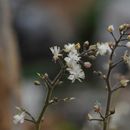en
names in breadcrumbs


Beesia is a genus of flowering plants in the buttercup family. It was named in 1915[2] after the plant nursery firm Bees of Chester, who financed the plant hunting trips of George Forrest and Frank Kingdon-Ward in China.[3]
There are two species of Beesia:[1]
Beesia is an evergreen perennial and grows as a dense basal rosette of heart-shaped leaves with delicate serrated edges. Leaves are soft and waxy; new growth of B. deltophylla flushes dark green to black, while B. calthifolia is a lighter shade of green. Small white flowers bloom mid-summer off an upright spike. Flowers are star-like: although Beesia flowers do not have petals,[7] they do have 5 elliptic, petal-like sepals.[8] Flowers also have many stamens.[8]
A class of organic molecules termed beesiosides have been isolated from Beesia plants.[9][10] Beesiosides are cycloartane glycosides (a type of triterpene that forms a sugar and a non-sugar upon hydrolysis).[9][11][12]
Anemonopsis, a monotypic genus in the Ranunculaceae native to Japan,[13] is a sister group to Beesia.[14][15] Eranthis and Actaea are also closely related to Beesia.[16]
Beesia is easily divided or grown from seed, and can be grown in USDA hardiness zones 6a to 8b. It grows best in partial shade or filtered light in rich, moist soil.
Beesia rhizomes are used in Chinese herbal medicine as a treatment for rheumatoid arthritis and influenza.[8]
{{cite web}}: CS1 maint: url-status (link) {{cite web}}: CS1 maint: url-status (link) {{cite web}}: CS1 maint: url-status (link) Beesia is a genus of flowering plants in the buttercup family. It was named in 1915 after the plant nursery firm Bees of Chester, who financed the plant hunting trips of George Forrest and Frank Kingdon-Ward in China.
Beesia es un género de plantas perteneciente a la familia Ranunculaceae. Se distribuyen por China, Burma y Tíbet. El género comprende 4 especies descritas y de estas, solo 2 aceptadas.[1]
Es una planta herbácea perenne con rizoma robusto. Las hojas son basales 2-4 y pecioladas, simples, cordadas y dentadas. Las flores son de color blanco, actinomorfas con 5 sépalos petaloides, sin pétalos y numerosos estambres. Las semillas son ovoides, globosas y rugosas.
El género fue descrito por Balf.f. & W.W.Sm. y publicado en Notes from the Royal Botanic Garden, Edinburgh 9: 63. 1915.[2] La especie tipo es: Beesia cordata Balf. f. & W.W. Sm.
A continuación se brinda un listado de las especies del género Beesia aceptadas hasta marzo de 2013, ordenadas alfabéticamente. Para cada una se indica el nombre binomial seguido del autor, abreviado según las convenciones y usos:
Beesia es un género de plantas perteneciente a la familia Ranunculaceae. Se distribuyen por China, Burma y Tíbet. El género comprende 4 especies descritas y de estas, solo 2 aceptadas.
Beesia – rodzaj roślin z rodziny jaskrowatych (Ranunculaceae). Obejmuje dwa gatunki występujące w Mjanmie i Chinach[3].
Byliny z tęgimi, pełzającymi i podnoszącymi się kłączami. Liście odziomkowe 2–4, długoogonkowe, pojedyncze o blaszce sercowatej lub sercowato-trójkątnej, na brzegu ząbkowanej. Kwiaty wyrastają w złożonej wierzchotce na głąbiku otulonym u nasady pochwiastymi liśćmi. Z poszczególnych węzłów kwiatostanu wyrastają 1–3 kwiaty wsparte szydlastymi lub lancetowatymi przysadkami. Kwiaty promieniste, podczas kwitnienia rozpościerają szeroko listki okwiatu. Zewnętrzny okółek składa się z 5 działek eliptycznych, białych. Okółka wewnętrznego brak. Pręciki są liczne, ich nitki nitkowate, a główki pręcika kuliste. Owocem są wolno stojące, długie, wąskie i spłaszczone mieszki. Zawierają po kilkanaście owalnych nasion[3].
Rodzaj z plemienia Actaeeae, podrodziny Ranunculoideae, rodziny jaskrowatych (Ranunculaceae)[4] z rzędu jaskrowców (Ranunculales), należących do kladu dwuliściennych właściwych (eudicots)[1].
Kłącza wykorzystywane są w lecznictwie ludowym przy bólach reumatycznych, grypie i obrzękach[3].
Beesia – rodzaj roślin z rodziny jaskrowatych (Ranunculaceae). Obejmuje dwa gatunki występujące w Mjanmie i Chinach.
铁破锣属(学名:Beesia)是毛茛科下的一个属,为草本植物。该属共有铁破锣(B. calthaefolia)和角叶铁破锣(B. deltophylla)2种,分布于缅甸和中国西南。[1]